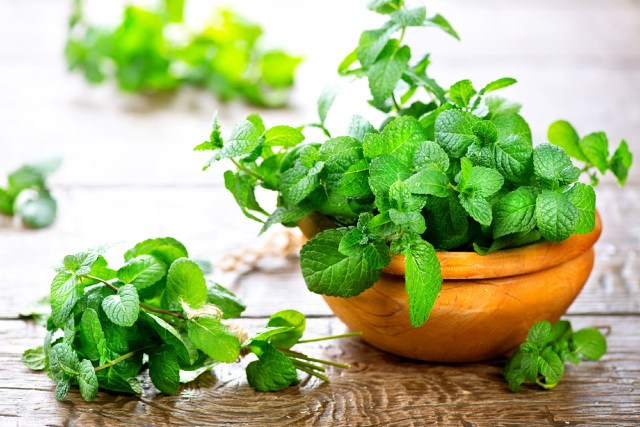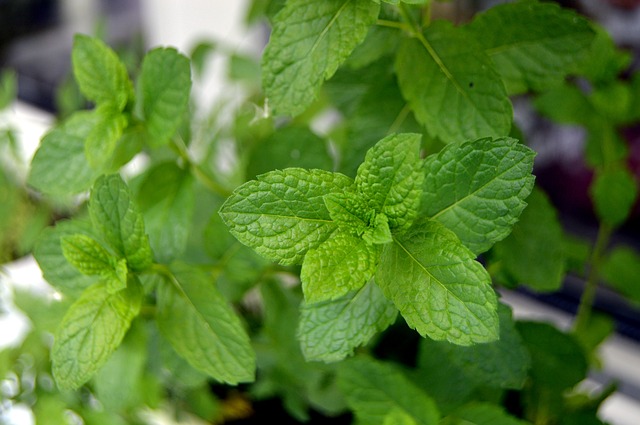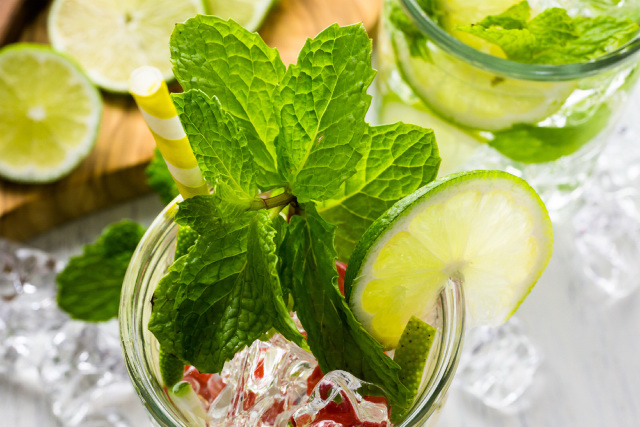Mint is a favorite herb to grow for many gardeners because it is easy to maintain and provides a prolific crop. It’s also delicious in a variety of dishes and drinks. However, occasionally mint can have a bitter taste. Keep reading to discover more about why this can happen and how to fix it.

Table of Contents
- Why Is My Mint Bitter? — The Short Answer
- Is It Dangerous to Eat Bitter Mint?
- How Should I Grow Mint for the Best Taste?
- How Does the Age of A Mint Plant Affect its Taste?
- Can Preparation Affect the Taste of Mint?
- Why Did Leaves On My Mint Plant Turn Purple?
- How Do I Fix A Dish with Mint that Tastes Bitter
- Could It Be My Tastebuds?
- Which Type of Mint has the Most Bitter Taste?
Why Is My Mint Bitter? — The Short Answer
Mint has many varieties that taste sweet and cool on the tongue. If your mint tastes bitter instead of sweet, the cause could be how you have planted and cared for the plant, the plant’s age, or how you prepare it in your dish or drink.
Is It Dangerous to Eat Bitter Mint?
No. It’s not dangerous to your health to eat mint that tastes bitter. However, generally, people do not like the taste of bitter foods, so it’s unlikely that you would want to consume a large amount of bitter-tasting mint.
How Should I Grow Mint for the Best Taste?

Ensure There is Enough Light
Although mint is a crop that is easy to grow, it does have a few considerations that affect its flavor profile. For the sweetest and best-tasting mint, you must ensure that it’s planted in healthy soil and receives enough sunlight during the day. Avoid planting mint in shady spots or areas of partial sun.
After I recently served some mint juleps at a backyard party, it inspired a friend to start growing her own mint. She set up the plant on a sunny windowsill, and although it grew fine, it just didn’t have the taste she expected. When she mentioned it to me, I suggested the planting location was the culprit.
Although many aromatic herbs will grow just fine in a windowsill garden, mint is one of those herbs that need to be planted outdoors in a sunny location. The reason has to do with the oils inside of the plant that gives it the minty taste.
The sun from the windowsill may be enough light for the mint to grow but not enough light for the oils to develop sufficiently. The plant will not acquire the expected sweet and minty taste if the oils don’t develop as they should.
Choose the Right Soil for Mint
For mint to thrive, it needs healthy soil and good drainage. If you water your mint plant and the water pools at the top, it’s a sign that the soil is not draining as it should. If your mint grows in an outdoor garden and you notice a lot of worms in the soil, that’s a good sign that your soil is healthy and has the nutrients it needs.
Also, avoid using fertilizers like Miracle Grow on your mint. Most delicate-tasting herbs do not do well with these types of fertilizers, and it will affect their taste.
If you feel your mint needs additional fertilization, stick to a natural fertilizer. The best one to use is aged manure. Even though it doesn’t smell pleasant, it provides the best nutrients. I like using Black Kow Manure on my herbs and vegetables. For a completely organic option, I sometimes choose Fishnure fish manure. If you’re into composting, you can also use your homemade compost to fertilize.
Don’t Overwater the Mint Plant
Finally, overwatering your mint plant can also affect its taste. Too much water in the plant leaves will dilute the oils and affect the minty taste. Generally, you do not need to water your mint plant every day. Usually, waiting until the soil drys out and watering it works fine. The exception would be if you were having a period of extreme heat or dryness.
Related Reading: How To Grow Mint: Complete Guide To Growing Mint At Home
How Does the Age of A Mint Plant Affect its Taste?
The younger leaves on a mint plant will taste better than the older ones. For this reason, it’s a good idea to regularly cut your mint throughout the season to encourage new growth. Cutting the older mint stems gives room for the newer stems to grow in, and these stems will have an enjoyable and sweet taste.
Additionally, mints usually taste most intense right before they flower at the end of the growing season. So your mint plant that tasted sweet and minty at the beginning of the season (springtime/early summer) may taste different towards the end of the growing season (late summer/fall).
I often find this fact true with my mint plants and enjoy the best mint earlier in the season. Remember that bitter-tasting mint in late summer doesn’t mean your plant is bad or unhealthy. It should grow back just fine the following year and produce great-tasting mint.
Since mint is so vigorous, consider harvesting a lot at the prime part of the season and chopping and freezing or drying it to use later.
Can Preparation Affect the Taste of Mint?

Since mint is a delicate herb best served fresh, I recommend not cooking it, as heating the leaves affects the taste. Cooking certain spices causes the aromatic compounds to vaporize. In turn, the leaves that remain do not taste very good.
When I need to add mint to a cooked dish, I put the freshly chopped mint on the food only when I’m about to serve it. Fresh mint is not one of those spices where the flavor does not benefit from simmering, except if you use dried mint leaves in your recipe.
When making tea with fresh mint leaves, don’t cush or muddle them first. Add the whole leaves to the hot water and steep it for 3 to 5 minutes. Then, pour the flavored tea into a separate cup, straining the leaves. Adding a sweeter like honey or lemon helps maintain and enhance the minty taste.
Additionally, if you are using mint in a cold drink (like a mint julep), your goal is to take the mint flavor out of the leaves and get it into the drink, but not keep the leaves themselves in the drink.
For this reason, a bartender will muddle the mint leaves, crushing them until they turn dark green but not over-crushing them. They will then prepare the drink and strain it into another glass to keep the mint flavor, not the leaves. Keeping the crushed mint leaves in the prepared drink will cause it to taste bitter. If you’d like to have some mint leaves in the drink as a garnish, put fresh ones in after preparing the drink.
Why Did Leaves On My Mint Plant Turn Purple?
When a mint plant’s leaves turn purple, it means that the plant did not receive the nutrients needed to develop the oils that make the mint flavor. If it’s not the whole plant but just a few leaves, pick them off and dispose of them.
If the whole mint plant turns purple and it’s not a variety of mint that should have purple leaves, adjust the soil and add manure or compost to make it healthier. Having healthy and nutritious soil should fix the nutrient problem with the plant.
It would be best if you did not eat the purple leaves of a mint plant. Although they will not make you sick, they will not taste sweet (since the flavor didn’t develop) and won’t make for a pleasant experience.
How Do I Fix A Dish with Mint that Tastes Bitter
If you’ve added mint to a recipe or a drink and find that it tastes bitter, you do not necessarily need to dispose of the dish. You can do certain things to counteract the bitter taste and salvage the dish.
Salty, sweet, and sour tastes will help to balance the bitterness. Try adding some more fresh mint, if available, and see if that helps balance the flavor. If that doesn’t work, a bit of lemon juice or salt may help.
Squeeze some fresh lemon in a cooked dish or drink with bitter-tasting mint or add a bit of salt and see if that makes it more pleasant.
Could It Be My Tastebuds?
If the mint you’re using only tastes bitter to you and not to others who try it, it could just be your taste buds. Different people taste different flavors. Just like many people think cilantro has a “soapy” taste, some people with very sensitive taste buds could find that certain foods taste bitter when they don’t taste that way to others.
Which Type of Mint has the Most Bitter Taste?
Most people either grow Peppermint or Spearmint. Understanding the differences in taste profiles between the two can help you with your expectations about the taste of mint.
Spearmint produces a much milder flavor than peppermint and is the one you want to use for salads, cocktails, and other prepared food dishes.
Peppermint has a much more robust and pungent taste. This difference is from the menthol content of the leaves. This mint is best used in tea or as a home remedy for treating an upset stomach.
Never use peppermint as a 1:1 substitute for spearmint. You should always use less, as too much peppermint will quickly make a dish unpalatable.
Other types of mint, like chocolate mint, apple mint, or orange mint, should also have a milder and more pleasing taste.
Related Reading:
